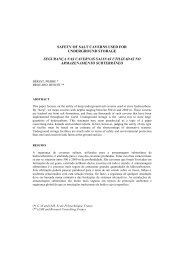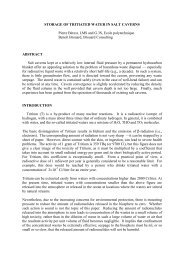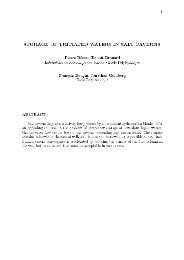ABANDONMENT TEST AT CARRESSE - Brouard Consulting
ABANDONMENT TEST AT CARRESSE - Brouard Consulting
ABANDONMENT TEST AT CARRESSE - Brouard Consulting
Create successful ePaper yourself
Turn your PDF publications into a flip-book with our unique Google optimized e-Paper software.
<strong>ABANDONMENT</strong> <strong>TEST</strong><strong>AT</strong> <strong>CARRESSE</strong>Technical ClassSMRI Fall Meeting – Leipzig, GermanyOctober 3, 20101MAIN OUTLINE• Main issues in salt-cavern abandonment• Carresse SPR2 cavern• In-situ measurements• Numerical computations• Computations performed by Ecole Polytechnique-BC• Computations performed by IUB• Main Conclusions21
MAIN ISSUESIN SALT-CAVERN<strong>ABANDONMENT</strong>3PRESSURE BUILD-UP INA CLOSED CAVERNfracture(After Van Sambeek, 1990) Vauvert (Bérest et al., 1979)42
MAIN CONCERNcavern sealed1. Why cavern pressure increases?2. How can we predict cavern long-term behavior?54 MAIN PHENOMENALEAKS• Rock salt behaves as a fluid• Brine warming is a very slow process• Salt permeability is exceedingly small• Leaks can be non negligible63
Cavern compressibilityCavern pressure increase/decrease7FACTORS CONTRIBUTING TO PRESSURE BUILD-UP• SALT CREEP → CAVERN CLOSURE• BRINE WARMING → THERMAL EXPANSIONFACTORS CONTRIBUTING TO PRESSURE RELEASE• ROCK SALT PERMEABILITY → BRINE MICRO-PERME<strong>AT</strong>ION• LEAKS (through casing, casing shoe, at well-head)84
ONE CAN DISTINGUISH 2 MAIN CASES1. Brine thermal expansion can be disregarded- Cavern is not ttall → final pressure smaller than geostaticti- Cavern is tall → overpressure possible at the roof2. Brine thermal expansion cannot be disregarded- Cavern is deep → it is necessary to wait for several years- Cavern is shallow → even a very small permeabilitycan prevent too large a pressure build-up9KEY POINT FOR A LONG-TERM <strong>ABANDONMENT</strong> <strong>TEST</strong>Accurate pressures and temperature measurementsare not enoughThe in situ test must be able to prove that there wereNO LEAKSduring the test, or tiny leaks that can be precisely measuredor back-calculated.105
<strong>CARRESSE</strong> SPR2– A small and shallow cavern –Not at thermal equilibrium11Carresse126
4 shallow caverns at CarresseSPR1SPR2OverviewSPR4SPR3VerticalCross-sectionSPR1SPR3SPR2SPR413SPR2 CAVERN00 ft)313 m (1009000 m 3(56,600 bbls)147
• SPR1, SPR2 & SPR4 were formerly used to store LPGSPR2geometricaltraps• Trapped propane was recover from SPR2 in 2003[de Laguerie et al., SMRI Fall Meeting, Berlin, 2004]22 metric tons of propane recovered15SPR2 CAVERN IS NOT <strong>AT</strong> THERMAL EQUILIBRIUMTemperature log20023 months0.58°C/year20021.1 °CT18.4 °CT 19.5 °CtMeasurement performed in 2002168
ONE CAN DISTINGUISH 2 MAIN CASES1. Brine thermal expansion can be disregarded- Cavern is not ttall → final pressure smaller than geostaticti- Cavern is tall → overpressure possible at the roof2. Brine thermal expansion cannot be disregarded- Cavern is deep → it is necessary to wait for several years- Cavern is shallow → even a very small permeabilitycan prevent too large a pressure build-up17IN SITUMEASUREMENTS189
Cavern pressure evolutionWELL KNOWNCavern compressibilityBrine thermal expansionNOT WELL KNOWNSalt creepSalt micro-permeationLeaksLONG-TERM FEM COMPUT<strong>AT</strong>IONS19Cavern pressure evolutionWELL KNOWNCavern compressibilityBrine thermal expansionNOT WELL KNOWNSalt creepSalt micro-permeationLeaksLONG-TERM FEM COMPUT<strong>AT</strong>IONS2010
2 years0.5 MPaSyracuseNancyBrussels21+1 MPaJune 20042211
WELL ST<strong>AT</strong>US FROM APRIL 22 TO SEPTEMBER 15 20057 mof oil23LEAK-DETECTION SYSTEM2412
WELLHEAD PRESSURESSeptember 15, 2005 oil injectionJune 2004June 2006April 200525WELLHEAD PRESSURES FROM SEPTEMBER 15 2005 TO MAY 20062 months2613
WELLHEAD PRESSURE FILTERING1 month~2 hours lag27DETERMIN<strong>AT</strong>ION OF CAVERN PRESSURE EVOLUTIONPressures at well headCavern pressure• columns composition• temperature log• oil/brine compressibilities• leaks2814
CAVERN PRESSURE EVOLUTION AS COMPUTED1 st stepNO OIL4 th step2 nd step3 rd step29Cavern pressure evolutionWELL KNOWNCavern compressibilityBrine thermal expansionNOT WELL KNOWNSalt creepSalt micro-permeationLeaksLONG-TERM FEM COMPUT<strong>AT</strong>IONS3015
CompressibilitytestV33.97 m /MPa31SALT ELASTIC PARAMETERS BACK-CALCUL<strong>AT</strong>EDBC-Ecole PolytechniqueIt was assumed: 0.25IUBIt was assumed: 0.35FEM fittingFEM fittingE 16,500 MPaE 17,800MPa3216
Cavern pressure evolutionWELL KNOWNCavern compressibilityBrine thermal expansionNOT WELL KNOWNSalt creepSalt micro-permeationLeaksLONG-TERM FEM COMPUT<strong>AT</strong>IONS33DETERMIN<strong>AT</strong>ION OF CAVERN TEMPER<strong>AT</strong>URE EVOLUTION1 st task: Determination of natural rock temperature T 2 nd task: Fitting of cavern temperature measurementAccurate prediction of brine thermal expansionduring and after the test3417
100 mSPR2SPR3700 m300 m35DETERMIN<strong>AT</strong>ION OF SPR2 N<strong>AT</strong>URAL ROCK TEMPER<strong>AT</strong>URESPR2310mT 19.5 °CSPR3700 m3618
SPR2 TEMPER<strong>AT</strong>URE MEASUREMENT IN 2002reference18.35°C – 0.58°C/year37Cavern TemperaturemeasurementT 19.5 °CAccurate predictionactualvirtualTimeJuly 20023819
CAVERN TEMPER<strong>AT</strong>URE FITTING (FEM computation, LOCAS)39CAVERN PRESSURE EVOLUTION WITH/WITHOUT BRINE HE<strong>AT</strong>INGHeating+creep>permeation+leakspermeation+leaks>creepBrine heating is the main phenomenon leading to cavern pressure increase4020
ETREZ EZ53 <strong>TEST</strong> (1997-1998) – NO BRINE HE<strong>AT</strong>INGpermeation>creepcreep>permeation41Cavern pressure evolutionWELL KNOWNCavern compressibilityBrine thermal expansionNOT WELL KNOWNSalt creepSalt micro-permeationLeaksLONG-TERM FEM COMPUT<strong>AT</strong>IONS4221
LEAKS DETERMIN<strong>AT</strong>ION43oil injection(Sept. 2005)Pressures at well headPressure difference3 rd step4 th stepoil injection(April 2004)4422
1 year70 hPa ~ 1 psi ≡ 1.8 meter ~ 5.9 ft3 rd step 4 th stepMaximum leak:V70 hPa in 1 year 0.397 liters/hPaAv. leak < 0.08 liters/day ~ 0.02 gal/day45WH pressure differenceWH temperaturewintersummer4623
Cavern pressure evolutionWELL KNOWNNOT WELL KNOWNCavern compressibilityBrine thermal expansionSalt creepSalt micro-permeationLeaksLONG-TERM FEM COMPUT<strong>AT</strong>IONS47SALT PARAMETERS TO BE DETERMINED: Salt creep parametersStationnary ti creepTransient creepNorton-Hoff parametersA, nQ , RMunson-Dawson parametersA , n , m, K , , c1 1o+ reverse creep Slhd Salt hydraulical lparametersKTHESE PARAMETERS MUST BE BACK-CALCUL<strong>AT</strong>EDAND/ORA SENSITIVITY STUDY MUST BE PERFORMED4824
Cavern pressure evolutionWELL KNOWNCavern compressibilityBrine thermal expansionNOT WELL KNOWNSalt creepSalt micro-permeationLeaksLONG-TERM FEM COMPUT<strong>AT</strong>IONS49Finite Element ComputationsbyLMS&<strong>Brouard</strong> <strong>Consulting</strong>Back-calculation of salt parameters5025
EXAMPLE OF SPR2 MESH4109 nodes – 7794 elements51ST<strong>AT</strong>IONNARY PARAMETERS FITTED FOR TWO PERIODSAverage pressure difference< 10 hPa (0.15 psi)5226
n = 5lt permeabilitySalNorton-Hoff lawQ n Aexp RT Norton A parameter5·10 -20 m²4·10 -20 m²FITTING SENSIBILITY HAS BEEN INVESTIG<strong>AT</strong>EDK 410 m20 2No orton n parameterSet #1Set #2Norton A parameter5427
MAIN FITTING RESULTS20 2 Salt intrinsic i i permeability:K 4 510 m Salt stationnary creep:Q n Aexp RT (Norton-Hoff law)-nA (/MPa -year)nQ R(K)Example of2 good sets of parameters:Set #1 2.5 2.5 4100Set #2 7.8 5 410055Norton-Hoff set #1hydK salt410 m20 2n 2.52.5A 2.5 /MPa -yearQ R 4100 K196420062238Set #15628
Norton-Hoff set #2hydK salt410 m20 2n 55A 7.8 /MPa -yearQ R 4100 KSet #257Norton-Hoff set #1hydK salt410 m20 2n 2.52.5A 2.5 /MPa -yearQ R 4100 KSet #15829
Norton-Hoff set #2hydK salt410 m20 2n 55A 7.8 /MPa -yearQ R 4100 KSet #259Finite Element ComputationsbyIUBSensitivity study on salt parameters6030
IUB STUDIES• data analysis• calculation of equilibrium pressure after sealing• determination of the most reliable parameter set• validation against test observations61s, %/d1,0E-01No lab test possibleCreep rate1,0E-021,0E-0310E04 1,0E-042SPR 2-7-1SPR 1-8-1SPR 2-8-1SPR 1-9-2SPR 3-1-11,0E-05LUBBY2 (all tests)1 10 1001 eq , MPaDeviatoric stress6231
CALCUL<strong>AT</strong>ION MODELdepth, m-297.0-303.0-305.0-307.0-313.0r = 1.36 mr = 6.74 mr = 6.00 mr = 18.10 m-321.363Results − Long Term PressureAssumed ModelLong Term PressureIncrease (MPa)reference 1.3higher creep ability 2.6lower creep ability 0.2higher permeability 0.9lower permeability 2.6hydrostatic far field p 0 0.9WIPP site far field p 0 1.76432
Norton-Hoff set #1hydK salt410 m20 2n 2.52.5A 2.5 /MPa -yearQ R 4100 K20061964IUB2.6 MPaSet #165PHENOMENA WHICH ARE ACTIVE DURING THE <strong>TEST</strong>PressureincreasePressuredecreaseBrine thermal expansion ≈1 liter/dayCavern closure (creep) ≈ 0.4 liter/dayBrine micro-permeation ≈ 0.6 liter/dayLeaks ≈ 0.1 liter/dayPHENOMENA WHICH ARE ACTIVE ON THE LONG TERMPressureincrease(MIT: ≈ 400 liters/day)Cavern closure (creep) ≈ 0.5 liter/dayPressuredecreaseBrine micro-permeation ≈ 0.5 liter/day6633
CONCLUSIONS A 2-year long abandonment test on a small and shallowcavern has been performed at Carresse, France. Parameters back-calculation, a sensitivity study, andlong-term simulations have been performed. The existence of an equilibrium pressure far belowgeostatic pressure has been confirmed. It has been proven that this cavern can be safely sealed. Final report is available for members on SMRI Website.6734
















